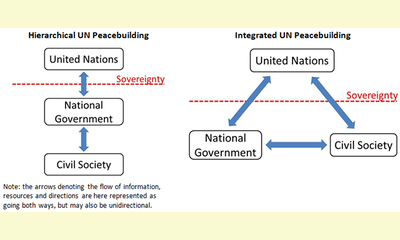|
|
Two Modes of UN Peacebuilding
un articulo por Patrick
In my opinion there are many ways to build peace, but to the United Nations (UN) they have two modes of peacebuilding: the Hierarchical and the Integrated. Both charts of the two modes show the flow of information between the United Nations, the National Government, and the Civil Society.

Chart of information Flow
click on photo to enlarge
After I read the article I was surprised that the two modes had quite a few differences such as different aims, Integrated mode depends more on help from the United Nations than the Hierarchical mode, and both modes do not remove the cause of violence in the country entirely, but sets up peaceful ways to deal with the cause of violence.
The article in my opinion gives the reader a good idea of what the United Nations peace building modes consist of, how they work, and how effect both modes are in a country. The figure below is the two charts on how information flows between the three main groups when building peace. Also there is a list of the differences and similarities of the Integrated and Hierarchical Mode which I believe gives the reader a better, detailed look at the two modes.
A point the author made was at the end there are four research questions that we can ask of the two modes:
What does the Sierra Leone experience tell us about the merits and challenges of each mode?
To what extent is the hierarchical mode insufficient and the integrated mode necessary for peace building success?
To what extent is civil society engagement and popular inclusion necessary for successful peace building?
What are the institutional obstacles that impede the UN from adopting the integrated mode?
Each question is critical about the UN modes of Peace building and how affective they are. To me both modes have their pros and cons and both do their best to help the country build peace. If a person reads this article when they are finished they should have a good opinion on UN Peacebuilding and how each mode is as the author put it, “two opposite ends of a spectrum and any present and future UN Peace missions will fall somewhere in between”(Lawrence).
Lawrence, Michael “Two Modes of UN Peace building, February 14, 2013.
|








|
DISCUSSION
Pregunta(s) relacionada(s) al artículo :
What is the United Nations doing for a culture of peace?,
* * * * *
Comentario más reciente:
:
Following the Second High Level Forum of the United Nations on the Culture of Peace, Anwarul Chowdhury, a former Under-Secretary General of the UN, had this to say about what the UN is doing for a culture of peace. His remarks were published by the Independent European Daily Express.
Civil society worldwide has been in the forefront of the global movement for the culture of peace, working diligently and patiently at the grassroots level, he said.
"I find it is the governments and power structures which are the most persistent foot-draggers with regard to advancing the culture of peace through policy steps and action," said Chowdhury, a former U.N. under-secretary-general and currently representing civil society and the Global Movement for the Culture of Peace. . .
The United Nations, he pointed out, has shown great vision by adopting its historic, norm-setting Declaration and PoA on the Culture of Peace in 1999, but has not been organised enough in making the document a system-wide flagship effort of the world body.
"I am a believer that the world, particularly the governments, will come to realise its true value and usefulness sooner than later," Chowdhury said.

|
|









